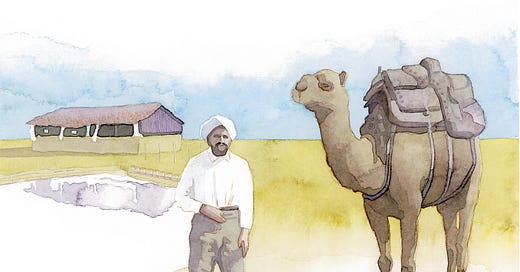In the 1860s, cameleers from Afghanistan, Pakistan, India and Iran were brought to Australia by British colonisers. The cameleers were employed to transport people and supplies by camel through the arid interior of the Continent. Cameleers connected the British colonial outposts of Adelaide, Darwin, Perth, Kalgoorlie, Broken Hill, Alice Springs, Broome and Marree. They serviced these routes from the 1860s until the 1920s. Cameleers were low paid, worked in harsh conditions and were subject to the control of the White Australia Policy.
Although the cameleers were commonly called ‘Afghans’ or ‘Ghans’, they came from several geographical regions, including Pakistan, India, Afghanistan and Iran. The cameleers were generally from low socioeconomic backgrounds and were offered three-year contracts by the British colonisers to work on the Continent. During the 30-year period from the 1860s to the 1890s, the population of cameleers numbered 800 workers.
Along colonial trade routes throughout the Continent, on the fringe of British colonial outposts, the cameleers made camps known as ‘Ghantowns’. An estimated 90% of the cameleers were Muslim and built mosques in the Ghantowns. Most of the Ghantowns were abandoned at the end of the camel industry, and only remnants remain. However, some mosques built by cameleers still operate in Broken Hill and Adelaide today.
The Maree Mosque, constructed as early as 1861, was the first mosque to be built by Muslim cameleer migrants. In 1887, Muslim cameleers built Broken Hill Mosque, also known as Mohammedan Mosque and Afghan Mosque. In 1888, cameleers financed the construction of the continent’s first metropolitan mosque, on Little Gilbert Street in Adelaide. By 1915 this mosque, which had cost the Afghan community around £3,000 to construct, had two high minarets, a garden with fig trees, vineyards and a cottage for visitors. Mosques were central to the Muslim cameleer community. During ramadan, Muslim cameleers throughout the continent would converge at the Adelaide Mosque.
The majority of cameleers were single men who made families on the continent by marrying local women. For the most part, they married Aboriginal women and only in a few rare cases married Europeans. due to the White Australia Policy, colonial state governments made it difficult for cameleers to marry European women. The children of cameleers and Aboriginal women were removed from their families as part of the stolen generation.
In the 1920s, the introduction of motor vehicle and railway transport increased across the continent, leading to the closure of the camel transport industry. The camels were released into the wild, becoming feral pests. This feral population numbers over one million today.
The closure of the cameleer industry occurred during the era of the White Australia Policy, under which the non-white cameleers were deported to Pakistan, India, Iran and Afghanistan. The cameleers were expected to pay for their own tickets back to their homelands, but many had survived on such a low income that they had no savings to afford their passage. Those cameleers who had Aboriginal families were given the option of remaining on the continent with their families.
REFERENCES
https://www.australiangeographic.com.au/topics/history-culture/2011/07/australias-afghan-cameleers/
https://www.abc.net.au/news/2020-02-02/descendents-remember-australias-cameleers/11890622
https://slwa.wa.gov.au/exhibitions/s/migration/page/afghan
https://www.southaustralianhistory.com.au/afghans.htm
https://adelaidia.history.sa.gov.au/subjects/afghans
https://origins.museumsvictoria.com.au/countries/afghanistan
http://www.migrationheritage.nsw.gov.au/exhibition/objectsthroughtime/broken-hill-mosque-collection/
https://www.environment.nsw.gov.au/heritageapp/ViewHeritageItemDetails.aspx?ID=5051563index.html
https://www.themonthly.com.au/issue/2017/september/1504188000/sam-vincent/hump-day#mtr
https://sahistoryhub.history.sa.gov.au/subjects/afghans
https://www.dpi.nsw.gov.au/biosecurity/vertebrate-pests/pest-animals-in-nsw/camels/feral-camels
https://nt.gov.au/environment/animals/feral-animals/feral-camel
https://pestsmart.org.au/toolkits/feral-camels/
https://www.bbc.com/news/newsbeat-51032145
http://www.bbc.com/travel/story/20180410-the-strange-story-of-australias-wild-camel



